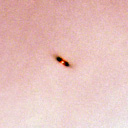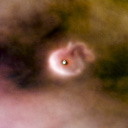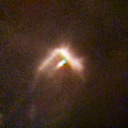Fitxategi:Orion Nebula with proplyd highlights (captured by the Hubble Space Telescope).jpg

Aurreikuspen honen neurria: 800 × 525 pixel. Bestelako bereizmenak: 320 × 210 pixel | 640 × 420 pixel | 1.024 × 672 pixel | 1.280 × 840 pixel | 2.560 × 1.680 pixel | 15.503 × 10.176 pixel.
Bereizmen handikoa ((15.503 × 10.176 pixel, fitxategiaren tamaina: 99,1 MB, MIME mota: image/jpeg))
Fitxategiaren historia
Data/orduan klik egin fitxategiak orduan zuen itxura ikusteko.
| Data/Ordua | Iruditxoa | Neurriak | Erabiltzailea | Iruzkina | |
|---|---|---|---|---|---|
| oraingoa | 18:14, 18 abendua 2009 |  | 15.503 × 10.176 (99,1 MB) | Tryphon | {{Information |Description=The en:Orion Nebula is home to tens of what could be fledgling en:planetary systems. In this image, six of these modest "smudges" with big potential are highlighted (from top down): [[:File:Proplyd 132-1832 in the Or |
Irudira dakarten loturak
Hurrengo orrialdeek dute fitxategi honetarako lotura:
Fitxategiaren erabilera orokorra
Hurrengo beste wikiek fitxategi hau darabilte:
- ar.wikipedia.org proiektuan duen erabilera
- en.wikipedia.org proiektuan duen erabilera
- fi.wikipedia.org proiektuan duen erabilera
- fr.wikipedia.org proiektuan duen erabilera
- hi.wikipedia.org proiektuan duen erabilera
- sv.wikipedia.org proiektuan duen erabilera
- zh.wikipedia.org proiektuan duen erabilera









